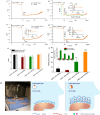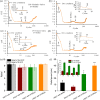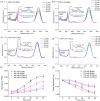Next Generation Salivary Lubrication Enhancer Derived from Recombinant Supercharged Polypeptides for Xerostomia
- PMID: 32463670
- PMCID: PMC8192052
- DOI: 10.1021/acsami.0c06159
Next Generation Salivary Lubrication Enhancer Derived from Recombinant Supercharged Polypeptides for Xerostomia
Abstract
Insufficient retention of water in adsorbed salivary conditioning films (SCFs) because of altered saliva secretion can lead to oral dryness (xerostomia). Patients with xerostomia sometimes are given artificial saliva, which often lacks efficacy because of the presence of exogenous molecules with limited lubrication properties. Recombinant supercharged polypeptides (SUPs) improve salivary lubrication by enhancing the functionality of endogenously available salivary proteins, which is in stark contrast to administration of exogenous lubrication enhancers. This novel approach is based on establishing a layered architecture enabled by electrostatic bond formation to stabilize and produce robust SCFs in vitro. Here, we first determined the optimal molecular weight of SUPs to achieve the best lubrication performance employing biophysical and in vitro friction measurements. Next, in an ex vivo tongue-enamel friction system, stimulated whole saliva from patients with Sjögren syndrome was tested to transfer this strategy to a preclinical situation. Out of a library of genetically engineered cationic polypeptides, the variant SUP K108cys that contains 108 positive charges and two cysteine residues at each terminus was identified as the best SUP to restore oral lubrication. Employing this SUP, the duration of lubrication (Relief Period) for SCFs from healthy and patient saliva was significantly extended. For patient saliva, the lubrication duration was increased from 3.8 to 21 min with SUP K108cys treatment. Investigation of the tribochemical mechanism revealed that lubrication enhancement is because of the electrostatic stabilization of SCFs and mucin recruitment, which is accompanied by strong water fixation and reduced water evaporation.
Keywords: Sjögren’s syndrome; biolubrication; dry mouth; ex vivo oral lubrication system; mucins; protein adsorption; recombinant supercharged polypeptides; saliva; salivary substitutes.
Conflict of interest statement
The authors declare no competing financial interest.
Figures







Similar articles
-
Recombinant supercharged polypeptides restore and improve biolubrication.Adv Mater. 2013 Jul 5;25(25):3426-31. doi: 10.1002/adma.201300188. Epub 2013 May 22. Adv Mater. 2013. PMID: 23696056
-
Enhancement in Xerostomia Patient Salivary Lubrication Using a Mucoadhesive.J Dent Res. 2020 Jul;99(8):914-921. doi: 10.1177/0022034520917675. Epub 2020 May 6. J Dent Res. 2020. PMID: 32374711 Free PMC article.
-
Dry mouth: saliva substitutes which adsorb and modify existing salivary condition films improve oral lubrication.Clin Oral Investig. 2020 Nov;24(11):4019-4030. doi: 10.1007/s00784-020-03272-x. Epub 2020 Apr 17. Clin Oral Investig. 2020. PMID: 32303864 Free PMC article.
-
[Use of saliva substitutes in patients with xerostomia].Schweiz Monatsschr Zahnmed. 2002;112(10):1037-58. Schweiz Monatsschr Zahnmed. 2002. PMID: 12442709 Review. French, German.
-
Human saliva and model saliva at bulk to adsorbed phases - similarities and differences.Adv Colloid Interface Sci. 2019 Nov;273:102034. doi: 10.1016/j.cis.2019.102034. Epub 2019 Aug 31. Adv Colloid Interface Sci. 2019. PMID: 31518820 Review.
Cited by
-
Acrylamide-based Saliva-gels as a Potential Xerostomia Treatment.ACS Appl Polym Mater. 2023 Oct 13;5(10):7698-7704. doi: 10.1021/acsapm.3c00438. Epub 2023 Sep 18. ACS Appl Polym Mater. 2023. PMID: 40061240 Free PMC article.
-
Preferences of Sjögren's syndrome patients regarding potential new saliva substitutes.Clin Oral Investig. 2022 Oct;26(10):6245-6252. doi: 10.1007/s00784-022-04576-w. Epub 2022 Jun 11. Clin Oral Investig. 2022. PMID: 35688954 Free PMC article.
-
Poly (hydroxyethyl methacrylate) Saliva-Gel: A Polymer-Based Solution for Xerostomia Treatment.ACS Appl Polym Mater. 2025 Jul 17:10.1021/acsapm.5c00881. doi: 10.1021/acsapm.5c00881. Online ahead of print. ACS Appl Polym Mater. 2025. PMID: 40687500 Free PMC article.
-
Emerging Landscape of Supercharged Proteins and Peptides for Drug Delivery.ACS Pharmacol Transl Sci. 2024 Feb 21;7(3):614-629. doi: 10.1021/acsptsci.3c00397. eCollection 2024 Mar 8. ACS Pharmacol Transl Sci. 2024. PMID: 38481692 Free PMC article. Review.
References
-
- Coles J. M.; Chang D. P.; Zauscher S. Molecular Mechanisms of Aqueous Boundary Lubrication by Mucinous Glycoproteins. Curr. Opin. Colloid Interface Sci. 2010, 15, 406–416. 10.1016/j.cocis.2010.07.002. - DOI
MeSH terms
Substances
LinkOut - more resources
Full Text Sources
Other Literature Sources
Medical

